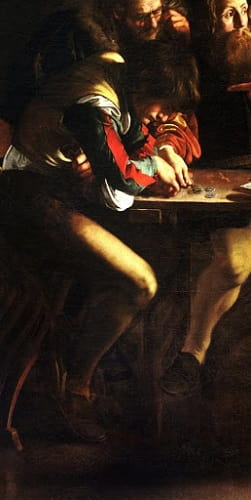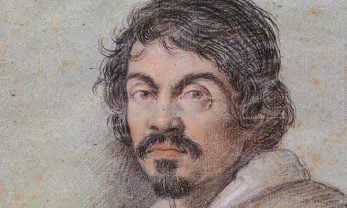10 Amazing Facts About The Calling of St. Matthew by Caravaggio
The Italian painter Michelangelo Merisi da Caravaggio, who lived in the sixteenth century, is regarded as one of the most influential artists in Christian art. Caravaggio is one of the pioneers of Baroque art, known for his flawless use of light and shadow, as well as his dramatic approach to composition in his paintings. In this article, we aim to present ten interesting facts about “The Calling of St. Matthew,” which is considered one of the finest examples of Caravaggio’s work. We also encourage you to contribute to our content by leaving your comments.
10 Things You Need To Know About Caravaggio’s The Calling of St. Matthew

The Calling of St. Matthew, 1599-1600 by Caravaggio | 10 Amazing Facts about The Calling of St. Matthew by Caravaggio
Recommended For You – The World’s 10 Most Valuable Paintings in Museums.
1- The Calling of St. Matthew Has Been On Exhibited In the Same Place For More Than 420 Years.
Since Caravaggio’s “The Calling of St. Matthew” was completed in 1599-1600, it has proudly been exhibited in the Contarelli Chapel, located in the church of San Luigi dei Francesi in Rome, for over 420 years.”

The Calling of St. Matthew, 1599-1600 by Caravaggio | 10 Things You Need To Know About Caravaggio’s The Calling of St. Matthew | The Contarelli Chapel at San Luigi dei Francesi-Rome
2- Caravaggio Was The Church’s Second Choice to Decorate the Chapel.
The late Cardinal Matteo Contarelli, for whom the chapel is named, left a sum of money for the decoration of the chapel. Initially, the task of decorating the chapel was assigned to Cavaliere d’Arpino, also known as Giuseppe Cesari, a renowned Mannerist painter in Rome during that period. However, after completing some of the frescoes on the chapel’s ceiling, Cavaliere realized he had taken on too many projects and subsequently canceled the agreement.”

A portrait of Giuseppe Cesari by Ottavio Leoni in 1621. | 10 Amazing Facts about The Calling of St. Matthew by Caravaggio
This turn of events led to the creation of one of Caravaggio’s most revered masterpieces.
3- The Painting of ‘The Calling of St. Matthew’ Depicts a Scene from Matthew’s Journey in the Bible.
Before being called by Jesus to become one of his apostles, Matthew was known as a greedy and immoral tax collector.
Caravaggio’s ‘The Calling of St. Matthew’ portrays the specific moment described in the Gospel of Matthew, chapter 9, verse 9, which states: “Jesus saw a man named Matthew sitting at the tax booth, and he said to him, “Follow me.” And he rose and followed him.’ “
4- Dimensions of The Painting.
The Calling of St. Matthew’s measures approximately 10.5 feet (about 3.2 meters) in width and 11 feet (around 3.35 meters) in height.
5- Caravaggio Uses Anachronism* To Make The Calling Of St. Matthew More Accessible.
In order to make the scene more relatable to his contemporary audience, Caravaggio employed anachronism in his painting. Rather than depicting the figures in period-specific clothing, he incorporated the fashion trends of the late 16th century.
*An Anachronism is a chronological inconsistency in some arrangement, especially a juxtaposition of persons, events, objects, language terms, and customs from different time periods. The most common type of anachronism is an object misplaced in time, but it may be a verbal expression, a technology, a philosophical idea, a musical style, a material, a plant or animal, a custom, or anything else associated with a particular period that is placed outside its proper temporal domain.
6- Caravaggio Uses Anachronism to Make ‘The Calling of St. Matthew’ More Accessible.
There has been speculation about Caravaggio potentially being one of the earliest practitioners of photographic technique.
In 2011, an exhibition at the National Museum of Piazza Venezia in Rome explored the theory that Caravaggio utilized an optical device to project images onto canvas. This intriguing proposition suggests that Caravaggio may have employed innovative methods similar to photography in his artistic process.

Matthew is pointing with his left hand | 10 Things You Need To Know About Caravaggio’s The Calling of St. Matthew
It is speculated that this technique could potentially explain why the figure representing Matthew in the painting is shown pointing with his left hand. If Caravaggio indeed used a projected image, it would have been mirrored, resulting in the reversal of left and right.
A camera obscura is a darkened room or box with a small hole or lens on one side, allowing an image to be projected onto the opposite wall or surface.
Recommended For You: 10 Places from Famous Paintings That You Can Visit in Real Life.
7- Caravaggio May Have Been Inspired by Hans Holbein.
Art historians have observed a resemblance between the depiction of tax collectors in Caravaggio’s ‘The Calling of St. Matthew’ and the composition of gamblers in woodcarving prints by the German painter Hans Holbein.
In Holbein’s work ‘The Gambler’ (1545), a man engrossed in counting his ill-gotten gains remains oblivious to the presence of death and the devil, who claim one of his companions. Similarly, in Caravaggio’s painting, a greedy tax collector is depicted as being so fixated on his money that he fails to notice the arrival of Christ. This parallel highlights a thematic connection between the two works, suggesting the possibility of Holbein’s influence on Caravaggio’s composition and message.”

Tax Collector in Caravaggio’s The Calling of St. Matthew

A man is so busy counting the wrongful gains that he doesn’t realize that death and the devil are claiming one of his friends. | The Gambler, 1545 by Hans Holbein.
8- It is not clear which man in the painting is actually Matthew, and there are various theories surrounding this question.
In the painting, Jesus and Peter are depicted on the right side, pointing toward Matthew. However, the specific individual addressed by their gesture and the identity of the soon-to-be saint among the men on the left has long been subject to speculation.
Some art historians argue that Matthew is the man bent over the coins, with the bearded man to his right pointing at him using his left index finger.
However, the most widely accepted interpretation suggests that the bearded man, slightly bending his index finger towards his chest, represents Matthew. According to this theory, the bright light shining on his face signifies the divine light of heaven, emphasizing his chosen status.
Yet, there are other art historians who believe that Caravaggio deliberately left the identity of Matthew ambiguous to convey the idea that God’s calling is open to anyone among them.
9- Caravaggio Might Have Been Influenced By Michelangelo.
As Caravaggio spent a significant amount of time working in Rome, it is highly likely that he was familiar with the Sistine Chapel, a masterpiece completed by Michelangelo in the early 16th century. The Sistine Chapel is renowned for housing some of the most significant works of Renaissance Art. It is plausible that Caravaggio was influenced by Michelangelo’s artistic achievements, considering their shared artistic milieu in Rome and the impact of the Renaissance era on their respective works.

The Creation of Adam, 1511 by Michelangelo
Art historians have suggested that the positioning of Jesus’ fingers in Caravaggio’s “The Calling of St. Matthew” mirrors the fingers in Michelangelo’s “The Creation of Adam,” which is seen as part of a tradition that interprets Christ as a second Adam. This comparison draws attention to the idea that Jesus, like Adam, brings about a new beginning or redemption for humanity. By incorporating such symbolism, Caravaggio may have sought to convey a deeper theological meaning within his painting.
10- Although Caravaggio was known for his tumultuous personal life, he made significant contributions to Christian art.
While Caravaggio’s artistic achievements, such as “The Calling of St. Matthew,” showcased his remarkable talent and impact on Christian art, his personal life was marked by controversies.
Caravaggio had a criminal record, often engaging in fights and displaying a quarrelsome nature. An incident is mentioned where he threw an earthenware dish at a waiter due to a disagreement over the preparation of artichokes. Despite these transgressions, church officials chose to forgive Caravaggio and allowed him to continue his artistic work.
This dichotomy between Caravaggio’s personal behavior and his artistic prowess adds an intriguing dimension to his legacy, demonstrating that individuals can possess both flaws and talents simultaneously.

Michelangelo Merisi da Caravaggio (1571-1610)
After being involved in a fatal altercation, Caravaggio was convicted of murder and sentenced to death, leading him to flee Rome. In an attempt to obtain a papal pardon, he joined the Knights of Malta. However, his time with the order was short-lived as he engaged in a fight with another knight.
Eventually, a cardinal intervened and granted Caravaggio forgiveness. Unfortunately, before the official pardon reached him, Caravaggio succumbed to a fever and passed away in 1610 at the age of 38. Despite the untimely end of his life, Caravaggio’s artistic legacy has endured for centuries, leaving an indelible mark on the world of art.
References:
- https://www.pivada.com/caravaggio-contarelli-sapeli
- https://www.mentalfloss.com/article/67050/15-things-you-should-know-about-caravaggios-calling-st-matthew
- https://en.wikipedia.org/wiki/Anachronism
- https://en.wikipedia.org/wiki/Camera_obscura









This is my first time paying a quick visit to this art world and I’m truly happy to read everything at a nearby place.
Thanks Franziska. Please stay follow for more interesting contents.